Using stabilizers in ice cream is essential for achieving a creamy texture and preventing ice crystal growth. They improve viscosity, enhance mouthfeel, and make your homemade ice cream more resilient to temperature changes. Common stabilizers like guar gum and sodium alginate help maintain consistency and smoothness. You’ll want to add them correctly, usually in powdered form and in specific dosages, to achieve the best results. There’s more to explore about combining stabilizers for unique textures that you won’t want to miss.
Key Takeaways
- Stabilizers improve ice cream texture by reducing ice crystal size, resulting in a smoother and creamier experience.
- They enhance viscosity, preventing ice crystal growth and ensuring a consistent creamy texture during storage.
- Common stabilizers like guar gum and sodium alginate can be mixed for optimal texture and stability.
- Proper application techniques, such as gradual mixing and precise measurement, are crucial for effective stabilization.
- Homemade stabilizers offer flexibility but may lack the consistency of commercial products designed for larger batches.
The Role of Stabilizers in Ice Cream Production
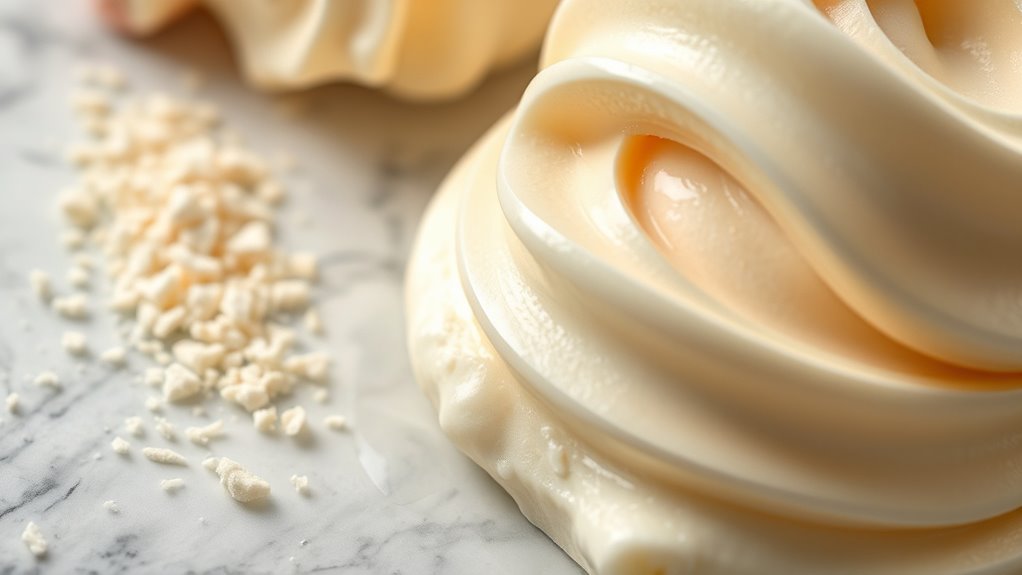
When you enjoy a scoop of ice cream, stabilizers play an essential role in creating that delightful texture and consistency. They improve the ice cream mix’s viscosity, enhancing creaminess and smoothness. In recipes like Sugar-Free Vanilla Ice Cream, the use of stabilizers can help maintain the desired texture despite the absence of added sugars. Additionally, incorporating ingredients like organic fruits can elevate the flavor profile of your ice cream.
Guar gum, carob bean gum, cellulose gum, xanthan gum, and carrageenan work together to manage water mobility and prevent ice crystal growth. This keeps your treat creamy and enjoyable, even after extended storage. Additionally, stabilizers help retain air, resulting in a lighter texture. They also prevent whey separation, ensuring a homogeneous mix.
By enhancing melting properties, stabilizers make your ice cream more resistant to warm temperatures, preserving that perfect scoop. Ultimately, they contribute to a satisfying experience with every bite you take, while the health benefits of enjoying a frozen treat can be enhanced by ensuring quality ingredients are used.
Key Benefits of Using Stabilizers

Stabilizers offer numerous advantages that greatly enhance the quality of ice cream. They improve texture by reducing ice crystal size, resulting in a smoother, creamier experience. You’ll notice smaller air bubbles that create a lighter, airier feel. Additionally, the use of stabilizers can mimic the creamy consistency found in frozen yogurt, providing an alternative for those seeking a lighter dessert option. Incorporating stabilizers can also help maintain the fiber content of ingredients, ensuring a nutritious profile for health-conscious consumers.
Stabilizers also increase viscosity, maintaining that delightful creamy consistency for longer, even during storage. They prevent ingredient separation, ensuring uniformity throughout. Plus, they slow down melting, making your ice cream more enjoyable in warmer conditions. Additionally, using stabilizers can improve color accuracy, which further enhances the visual appeal of the final product.
Common Stabilizers and Their Functions

The benefits of using stabilizers in ice cream are clear, and understanding the specific types and their functions can further enhance your creations.
Guar gum, for instance, increases viscosity and improves texture, while carob bean gum reduces ice crystal growth for a smoother experience. Additionally, many ice cream makers appreciate the culinary scene in urban areas, which often inspires unique flavor combinations. Fresh orange juice is another refreshing ingredient that can be creatively incorporated into ice cream recipes for a burst of flavor.
Cellulose gum effectively suppresses ice crystals and adds body, making your ice cream feel richer. Sodium alginate is great for low-fat options, enhancing creaminess without extra fat.
Locust bean gum often works in tandem with other gums to create a synergistic effect. These stabilizers help manage air bubbles, enhance flavor delivery, and slow melting, ensuring your ice cream maintains its delightful texture and taste longer. Additionally, proper storing essential oils can also contribute to maintaining the quality of flavoring agents used in ice cream formulations.
Effects of Stabilizers on Ice Crystal Formation

Although you may not think about it, the size and formation of ice crystals greatly impact your ice cream’s texture and overall quality.
Stabilizers play a critical role in controlling this process. By increasing the viscosity of the unfrozen serum phase, they reduce water diffusion to ice crystals, limiting their growth. This means you can enjoy a smoother texture as stabilizers bind water molecules and form a gel-like network around ice crystals. Additionally, the use of stabilizers can enhance skin health by ensuring a creamier and more enjoyable treat without compromising on quality. In fact, the growth of the beauty industry has led to a greater consumer focus on high-quality ingredients in all products, including food.
Without stabilizers, ice crystals can grow larger, resulting in a coarse, icy texture. Additionally, stabilizers help maintain the initial crystal size during storage, ensuring your ice cream stays consistently smooth and enjoyable, even through temperature fluctuations. Moreover, the incorporation of ingredients like chia seeds, known for their water absorption properties, can further enhance the overall texture and quality of your ice cream.
How Stabilizers Impact Melting and Scoopability
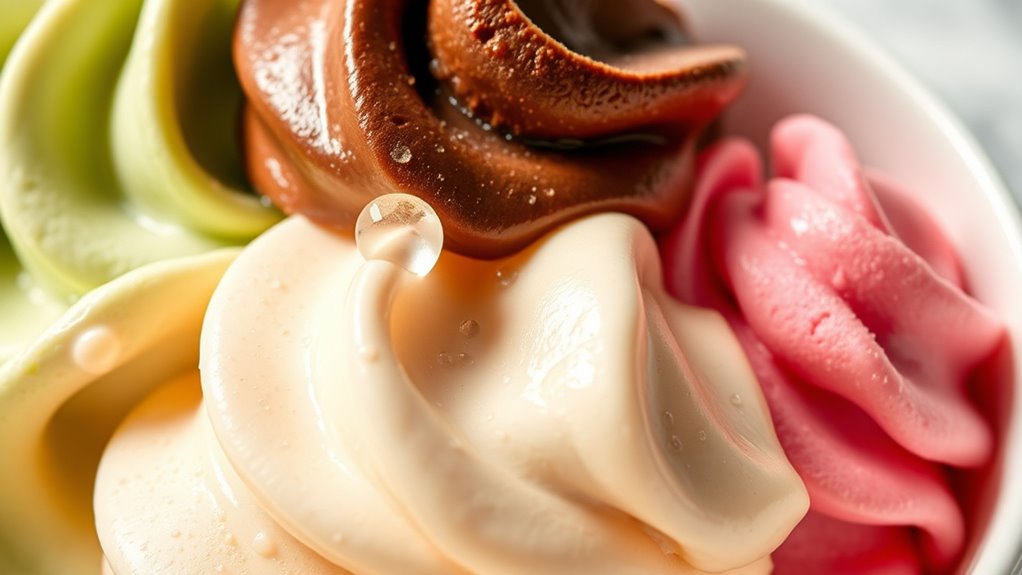
Ice cream’s texture doesn’t just rely on ice crystal formation; it also greatly affects how your treat melts and how easily you can scoop it.
Stabilizers slow down melting by increasing viscosity and keeping air bubbles small, allowing your ice cream to hold its shape longer. This means it melts more slowly, so you can enjoy it without a mess. Additionally, a raw food diet can improve your overall digestion, which might enhance your enjoyment of various foods, including ice cream. Moreover, the use of necessary cookies on websites can enhance user experience, similar to how stabilizers improve the ice cream experience.
Additionally, stabilizers enhance scoopability by preventing ice crystals from forming, ensuring a smooth, consistent texture even after storage. You’ll find that ice cream remains soft and easy to scoop without crumbling. Plus, the creamy mouthfeel makes it a delight to dig into. With stabilizers, you get a product that stays deliciously enjoyable from the first scoop to the last. Ice cream consumption in the U.S. highlights how important texture and melting characteristics are to consumers’ enjoyment.
Differences Between Commercial and Homemade Ice Cream Stabilizers
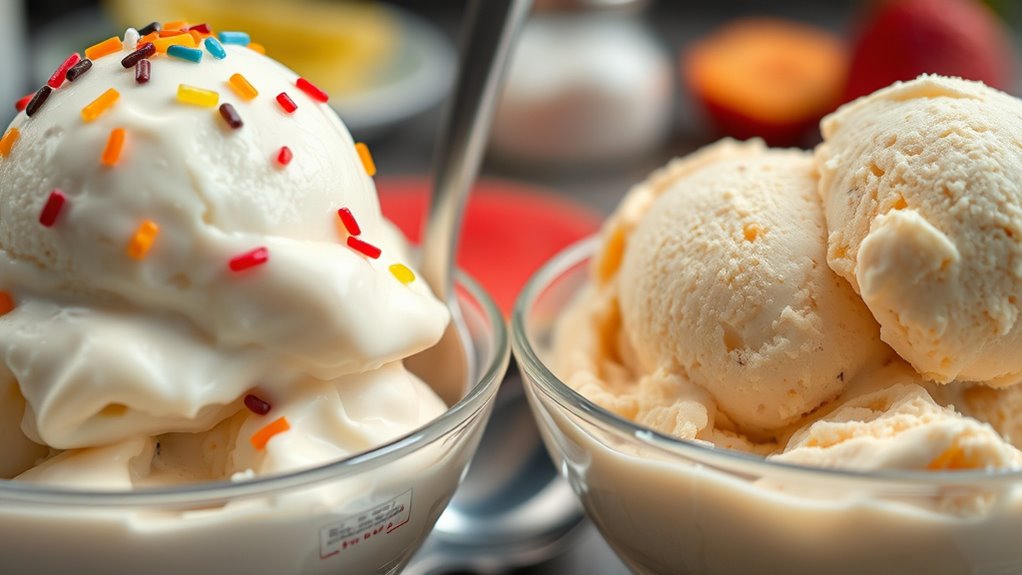
When comparing commercial and homemade ice cream stabilizers, you’ll notice significant differences in their formulations and applications.
Commercial stabilizers, like guar gum and carrageenan, are often blended with emulsifiers to guarantee a consistent texture across large batches. These products are designed for extensive distribution, requiring stabilizers that maintain quality during varied storage conditions. Additionally, achieving a creamy texture is crucial for both commercial and homemade ice cream, as it affects the overall mouthfeel. Regular consumption of ice cream can have health implications, particularly regarding cholesterol levels in individuals who may be affected.
In contrast, homemade ice cream stabilizers are usually limited in variety and may not achieve the same level of consistency. You also have more flexibility in ingredient selection, as homemade recipes aren’t bound by commercial regulations.
However, accessing high-quality stabilizers can be challenging for home producers, affecting your ice cream’s final texture and shelf life. Additionally, understanding the importance of air quality considerations can help you create a better environment for ice cream storage, ultimately preserving its quality.
Recommended Stabilizer Application Techniques

To achieve the best results when using stabilizers in ice cream, you’ll want to follow specific application techniques that enhance texture and stability.
Start by adding stabilizers in powdered form to guarantee even distribution throughout your ice cream base. Make sure to mix thoroughly to avoid clumping, and consider heating stabilizers like Locust Bean Gum to fully hydrate before cooling. Additionally, using herbal infusion machines can help achieve unique flavors in your ice cream by allowing for the incorporation of infused ingredients. Understanding the mechanics of French press coffee can also inspire creative flavors, as the infusion process is similar.
Gradually add stabilizers during mixing for consistent dispersion, and pay attention to whether you’re using cold or hot mixing techniques based on the stabilizer type.
For ideal texture, consider combinations like Sodium Alginate with K-Carrageenan or Guar Gum with Locust Bean Gum to improve viscosity and prevent issues like wheying-off, guaranteeing a smoother, creamier final product. Additionally, incorporating butter’s rich flavor can further enhance the overall taste and mouthfeel of your ice cream.
Optimal Dosages for Stabilizers in Ice Cream

Finding the right dosages for stabilizers in ice cream is essential for achieving the perfect texture and consistency. Generally, you’ll want to use stabilizers within a concentration range of 0.1% to 0.5% of your base mix.
For example, 0.2% sodium alginate can considerably enhance viscosity. Keep in mind that the type of product influences your stabilizer choice; low-fat ice creams might require sodium alginate. Incorporating fiber-rich ingredients like chia seeds can complement the stabilizing effects by enhancing texture and nutritional value. Additionally, using stabilizers can help maintain the nutritional value of your ice cream by preventing the formation of ice crystals that can dilute flavors. The iterative processes involved in refining your recipe will ensure that you achieve the best possible outcome. Be cautious, though—over-stabilization can lead to gumminess or sliminess, compromising your ice cream’s mouthfeel. Always measure stabilizers accurately using digital scales to prevent errors.
Combining Stabilizers for Enhanced Performance
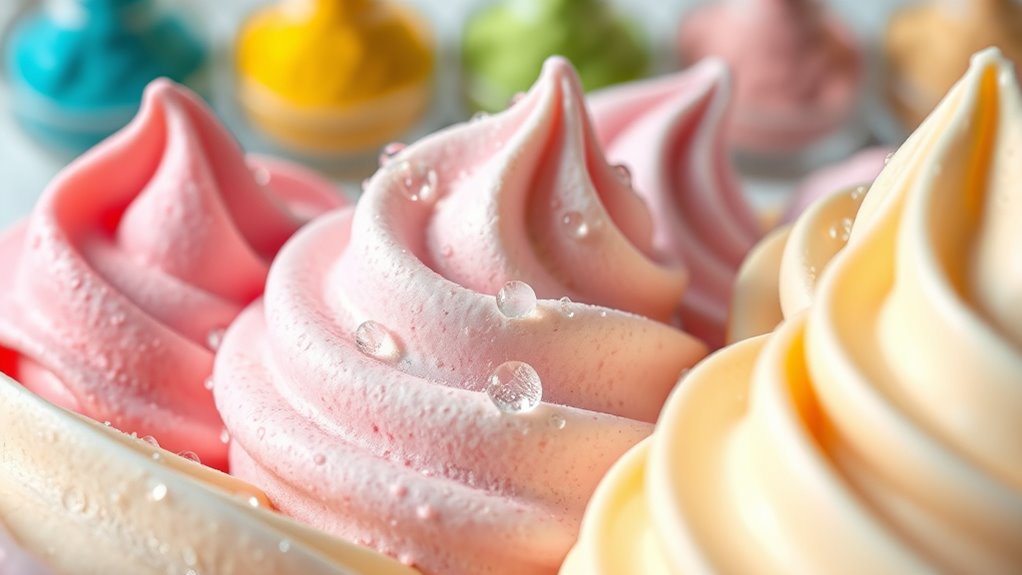
Combining stabilizers in ice cream not only enhances texture but also improves overall product stability and shelf life.
When you mix stabilizers like guar gum and carob bean gum, you effectively manage water mobility, which reduces ice crystal growth. This synergy leads to a creamier texture and extended shelf life.
For instance, blending sodium alginate with carrageenan increases viscosity and maintains quality. Similarly, pairing guar gum with locust bean gum controls ice crystal size and adds body.
You’ll find that low-viscosity gums can also improve sensory properties while offering cost efficiencies.
It’s essential to tailor these blends to your specific ice cream formulation, ensuring you achieve the desired texture and performance. Testing different combinations can reveal the perfect balance for your product.
Experimenting With Stabilizers for Unique Textures
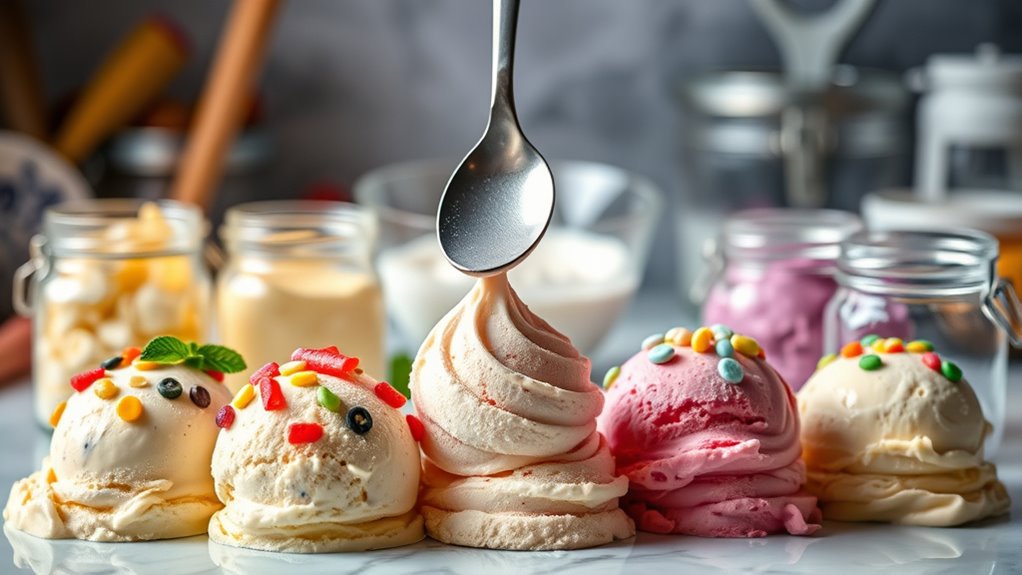
Experimenting with stabilizers opens up a world of possibilities for creating unique textures in ice cream. By using guar gum, you can achieve a smoother consistency, while xanthan gum helps improve texture and prevent separation.
Carrageenan enhances creaminess and stabilizes dairy proteins, making your ice cream richer. Locust bean gum reduces ice crystal formation, resulting in a smoother mouthfeel.
If you’re crafting low-fat ice creams, sodium alginate can be particularly effective. Balancing the concentrations of these stabilizers—typically between 0.2-0.5%—is key.
Test different ratios and combinations to discover unique textures and qualities, ensuring you avoid gumminess. With a bit of experimentation, you can create ice cream that not only tastes great but also feels amazing in your mouth.
Frequently Asked Questions
Are Stabilizers Safe for All Consumers, Including Those With Allergies?
Stabilizers aren’t universally safe for all consumers, especially if you have allergies.
While many stabilizers come from natural sources, some can trigger allergic reactions or digestive issues in sensitive individuals. For example, carboxymethylcellulose (CMC) may cause severe reactions.
It’s essential to read labels carefully and be aware of your specific sensitivities. Opting for high-quality, natural stabilizers can help minimize potential adverse effects, but always prioritize your safety and comfort.
Can I Use Natural Alternatives Instead of Commercial Stabilizers?
Imagine crafting a symphony of flavors, where natural alternatives take center stage instead of commercial stabilizers.
You can absolutely use these options, like citrus fiber or tara gum, to achieve that creamy texture you desire. They not only enhance the ice cream but also resonate with the clean label movement, appealing to health-conscious consumers.
Just remember to adjust your recipes, as the effectiveness of these natural substitutes can vary in their delicate dance with your ingredients.
How Do Stabilizers Affect the Flavor of Ice Cream?
Stabilizers can considerably impact the flavor of ice cream. They help maintain flavor by controlling water mobility, which prevents dilution.
Some stabilizers might slightly mask lighter flavors, while others, like locust bean gum, can introduce subtle sweetness.
By optimizing texture, stabilizers enhance the overall flavor experience, making it smoother and creamier.
Choosing the right stabilizer and balancing it with other ingredients are key to achieving the best flavor profile in your ice cream.
Do Stabilizers Change the Nutritional Value of Ice Cream?
Did you know that stabilizers like guar gum and xanthan gum are fundamentally calorie-free?
When it comes to ice cream, stabilizers don’t greatly change its nutritional value. They help maintain ingredient homogeneity, ensuring nutrients are evenly distributed without adding extra calories.
While some stabilizers can enhance the nutritional profile with proteins or minerals, their overall impact is minimal, allowing you to enjoy your treat without worrying about altering its nutritional balance.
Can I Make Ice Cream Without Any Stabilizers?
Yes, you can make ice cream without any stabilizers! Focus on balancing your water and fat content for the best texture.
Use high-quality dairy and consider a custard base with egg yolks for natural emulsification. Guarantee proper freezing and handling to prevent ice crystals.
By controlling the temperature during churning, you’ll achieve a smooth, creamy result.
With these techniques, you can enjoy delicious, stabilizer-free ice cream that still satisfies!
Conclusion
Incorporating stabilizers into your ice cream isn’t just a technical choice; it’s a way to elevate your creation to creamy perfection. By understanding their role, you can master the art of texture and scoopability, ensuring your ice cream doesn’t just melt away but lingers delightfully on the palate. Embrace the dance of stabilizers and let your imagination run wild; after all, the right balance can transform your frozen treat into a truly unforgettable experience.










